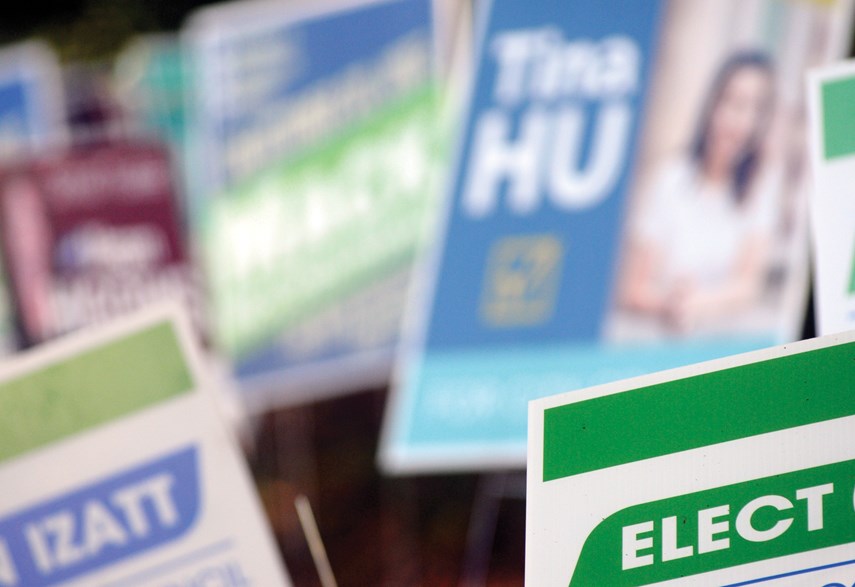Are massive election signs outdated and bad for the environment, or do they help voters notice candidates and inspire them to vote in local government elections?
These are the big questions the District of North Vancouver council was mulling over at the Jan. 11 general meeting, when councillor Jordan Back put forward a motion calling for the groundwork to be done to limit the size of election signs in the district.
At the moment, in the district, election signs can be as big or as small as a candidate would like, and they can go almost anywhere.
Back is hoping to change that. Although, not everyone is on board. The motion, which was eventually carried four to three, sparked a 40-minute-long discussion among councillors on whether large-sized election signs are a problem, the environmental impacts of sign materials, and if signs are still beneficial in the age of social media.
The district is the only municipality on the North Shore that doesn’t have size guidelines for election signs. According to the report, there are also no restrictions on where election signs can be posted, except as provided in the "Street and Traffic Bylaw 7125, 2004” and provincial restrictions in regard to Highway right-of-way.
The only requirement listed is that election signs must be removed within seven days of the election.
“We currently have no restrictions on the size of election signs in our community, and as a result, every election period, we do see a proliferation of signs across the community of all shapes and sizes,” said Back, speaking at the council meeting.
He said the unrestricted, large election signs impacted the streetscape and neighbourhoods, could cause visual obstructions for drivers or those who walk or roll, and the volume of materials, including hard plastics, had a negative environmental impact.
“While there are many other ways to connect with the community in an election campaign, such as door-knocking, attending events throughout the community, speaking at all-candidates meetings, and having an effective social media strategy, I think signs still play an important role, and that's why I'm not by any means proposing a ban on election signs, but I do think restricting the size and putting us in line with the City of North Vancouver would be a positive move,” said Back.
In the city, election signs are limited to 0.4m2 in area and 1.8 m in height (6 ft.). The District of West Vancouver has more liberal restrictions, being 3m2 in area and 2.5 m in height (8 ft).
In the report, Back also highlighted that there was no permit requirement for election signs either, so there is no accurate count on the number of signs put up during an election.
Mayor Mike Little supports larger election signs
Councillors' views on election signs varied, with some believing they are the most effective way to get noticed and others saying they were no longer beneficial and aren't environmentally friendly.
Mayor Mike Little voted against the motion, saying large signs created a focus point for other signs at a location and reduced the likelihood of a “proliferation of small signs” throughout the community.
“There's no proliferation of small signs down the side streets. They all happen in the one central location because that becomes the spot where everybody wants to be,” he said.
“I fully support any limitations that are directly related to safety or protection of infrastructure. What this report looks like it’s doing is verging into the aesthetic.”
He said smaller signs ended up “strewn about everywhere," and were difficult to read, while larger signs offered more opportunity for clear messaging.
Speaking quite passionately, Little reminisced about his first election campaign and how a few simple A-Frame signs helped him get noticed.
“In my first election campaign, when I was 26 years old, I couldn't afford a mail load, I couldn't afford newspapers, my total budget was $600, and out of it I bought six signs and put them on three A-frames and just kept moving them around the community just to try and seem like I actually had some budget – I finished 14 out of 21 candidates,” he said, adding that he believed the value of running a sign campaign far outweighed the value of a newspaper ad, especially for young up and comers.
Meanwhile, Coun. Megan Curren supported the motion but said she’d like to see things move a step further, with a complete ban on election signs in the district.
“Signs are expensive and they’re pollution,” she said.
“I don't see a lot of benefits. There's actually been a few social science studies that have shown that they actually don't help.”
She added that municipalities across Canada had begun banning election signs on public property, mentioning Brampton and Kingston in Ontario and Surrey in B.C.
Councillors Lisa Muri and Betty Forbes, like the mayor, did not support the motion.
“I believe they're actually the most efficient way of drawing attention and the most affordable way of drawing attention to a candidate,” said Muri.
“The newspaper ads are horrifically expensive, and the signs provide an indication of a democratic process that is a very short period of time – really the signs go up for about a two-week period.”
Forbes added she wasn’t too concerned about the size of signs, more so the number of the same signs in one location, suggesting more discussion was needed on the topic.
Mathew Bond and Jim Hanson both supported limiting the size of signs and looking for more environmentally friendly options to reduce waste, saying they’d like to hear more from staff on the matter and have further discussions.
Staff will now report back to council on options for limiting the size and height of election signs in the district and other issues raised in the discussion.
Elisia Seeber is the North Shore News’ Indigenous and civic affairs reporter. This reporting beat is made possible by the Local Journalism Initiative.



